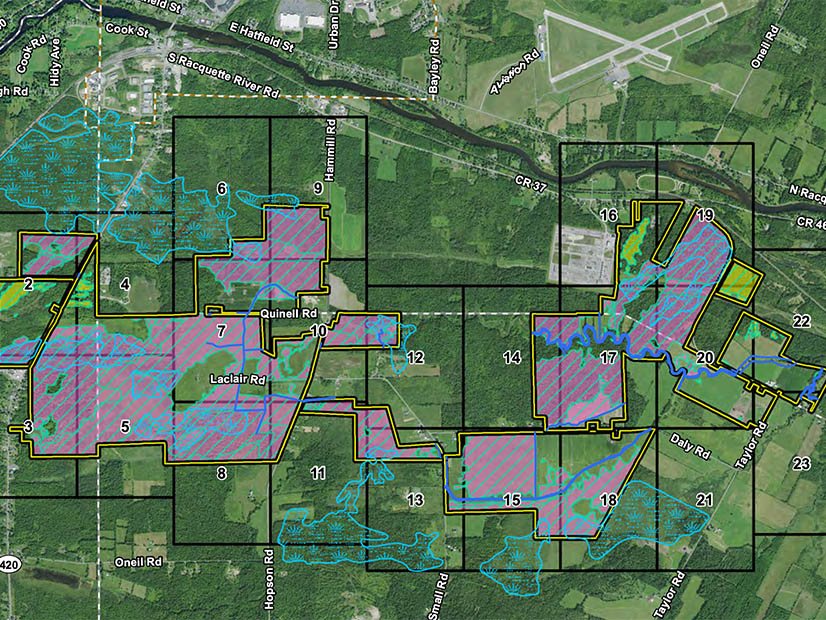
A NextEra Energy (NYSE:NEE) subsidiary developing a 180-MW solar project in upstate New York since 2017 is urging the state’s Siting Board to reject as “faulty” the Department of Environmental Conservation’s project description and analysis, especially on wetlands classification and mitigation (Case No. 17-F-0598).
In a December rebuttal to DEC staff testimony the previous month, North Side Energy Center said it was illogical for the department to classify the project as an industrial-use facility and thus render it incompatible with state wetlands regulations.
North Side said the term “industrial use facility” dates from 1985 and is associated with impacts from constructing buildings, accessory roads and parking areas that can impede rainwater absorption and roil streamflow, in turn creating more erosion and sedimentation.
“Here, solar technology for the project was selected to avoid concrete foundations. There will be no buildings. Panels will be mounted on racking systems supported by driven posts, resulting in minimal ground disturbance,” said North Side, a wholly owned, indirect subsidiary of NextEra Energy Resources, itself a subsidiary of NextEra.
Access roads for the 2,200-acre project, sited a few miles from the Canadian border, will not be paved entirely, but virtually all of the roads will be gravel, allowing rain to soak into the ground. Therefore, North Side argued, the project will not create the kind of impact imagined when industrial-use facilities were included in state regulations.
The Siting Board will rule in July on the project’s application for a certificate of public convenience and necessity. Meanwhile, three administrative law judges have established a procedural timeline, with a status conference this Friday followed by a Jan. 14 deadline for submission of exhibit list; witness list and testifying order; contested issues; and areas for cross examination.
An evidentiary hearing will be held Jan. 24, with post-hearing briefs due Feb. 28 and reply briefs on March 15.
Evaluation Crosstalk
DEC biologist Christopher Balk testified in November that department staff calculated that the project, as currently proposed, will result in direct impacts to 621 acres of protected wetlands and 136 acres of adjacent areas.
Asked if DEC staff were commenting on the applicant’s system energy efficiency plan (SEEP) guide as it related to wetlands and waterbodies, Balk said, “No, department staff’s proposed certificate conditions differ from the applicant’s in such a manner that review of the SEEP guide as it relates to wetlands and waterbodies would not result in any meaningful comments from staff.”
North Side argues that DEC staff assume that the entire area under the panels — which it says will be reseeded and restored and which the record shows will improve functions to previously disturbed wetlands — should be treated as an avoidable adverse impact and thus requires mitigation.
The “regulation [that the department] asks the Siting Board to exert over non-mapped wetlands is unprecedented, limitless, prejudicial and groundless. By adopting this ad hoc, unlawful approach to wetland regulation, developers will not be able to rely upon existing law and regulations for fear that the DEC staff will go beyond it,” North Side said.
DEC staff recommend approximately 1,100 acres of wetlands be created or restored to serve as mitigation, which North Side said would make the project unfinanceable. The market rate from a least one organization that creates wetland mitigation (Ducks Unlimited) is approximately $100,000/acre, the developer said.
By that estimate, DEC staff’s recommendation would mean a wetland mitigation cost of approximately $110 million for a solar project for which the capital cost is approximately $300 million.
Alternatively, DEC staff argue that the Siting Board amend the official wetland maps and treat the non-mapped wetlands as Class I, which would prohibit any facilities from being located there.
“As the applicant has no alternative site, that DEC strategy would also kill the project,” North Side said.
It also noted that a preliminary jurisdictional determination issued in October by the U.S. Army Corps of Engineers (USACE) said it will exert jurisdiction over those non-mapped wetlands, so the company would not seek a permit from it.
A crucial difference between the corps’ requirements and the DEC staff position in this case is that USACE requires compensatory mitigation only for permanent jurisdictional wetland losses resulting from the placement of fill for activities such as grading, the construction of access roads and placement of concrete pads, North Side said.
“The USACE does not recognize the installation of driven piles (such as the solar array posts) into wetlands as fill and therefore the placement of the solar racking system and the panels themselves would not require mitigation, as the action would be non-jurisdictional to USACE,” North Side said.
Compatibility Tests
A project in New York must pass three compatibility tests in order to be permitted:
- would be compatible with preservation, protection and conservation of the wetland and its benefits;
- would result in no more than insubstantial degradation to, or loss of, any part of the wetland; and
- would be compatible with the public health and welfare.
North Side argues that the project meets all three tests. It says most of the proposed impacts are in the form of conversion, which typically constitutes conversion of land cover through clearing of non-aquatic vegetation associated with panel installation to eliminate the potential of shading effects caused by vegetation. In addition, the discontinuance of agricultural activity will improve wetlands in areas used for row and field crops, the company said.
The project meets the second test because placing solar posts, access roads and inverter and substation pads do not amount substantial degradation of the land, the developer said. It also said it is ready to comply with USACE mitigation requirements, which it estimates would amount to approximately 15 acres of wetland mitigation.
Finally, North Side said the project meets the third test because no significant adverse impact on the environment, public health and safety were determined through the many studies it performed to prepare the application.

